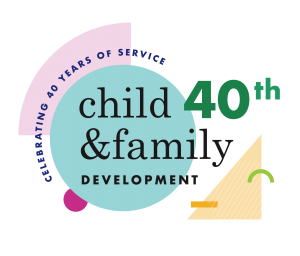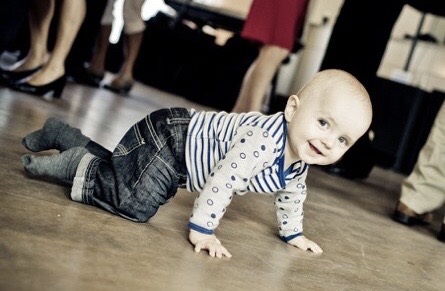By Guest Blogger, By: Mallory Bushee OTR/L, Child & Family Development
The milestone of crawling is a meaningful stepping stone in childhood development. Crawling is more than just a check box on a developmental form, more than the headache of baby-proofing the entire house, and more than that picture perfect accomplishment to video share with all your family and friends. For infants and toddlers, crawling may be challenging or scary to learn but it is the groundwork for future progress. Within the profession of childhood development, we are seeing more kids who bypass crawling (“Look at me, who needs crawling, here I come Ivy League schools”) and more kids with atypical movement patterns in place of reciprocal crawling (“I’ve got my own style, who needs right/left, and they all think it’s so cute when I do it”). Don’t get me wrong, I am all for kids meeting and exceeding expectations and finding their unique entity. However, when it comes to crawling let’s please stick with what we know, and here is what we know:
– Reciprocal crawling connects both sides of the body and both hemispheres of the brain. Bilateral coordination is when we are using opposite sides of the body to work together. Crawling is a prime example of these contralateral movement patterns in action – the left arm moves as right leg moves and vice versa. These movement patterns activate a portion of the brain (the Corpus Callosum) which helps the left and right hemispheres of the brain communicate with each other. Communication between the two hemispheres is not hard wired and is necessary for building more complex coordination (walking, running, writing, scissor use, and so much more).
– Maneuvering through the environment with hands and knees on the ground is a once in a lifetime adventure in sensory exploration for a little one leaning about his or her senses. It provides input to nearly all of the developing sensory systems: tactile, visual, vestibular (movement), and proprioceptive (muscle and joint). Furthermore, it develops curiosity and awareness of their own self within the environment.
– The eye movements necessary for a child to look between his or her destination in the distance and back to their hands moving on the floor aid in development of visual skills. This is called binocular vision and can establish healthy near and far vision and build a child’s visual tracking skills.
– Crawling builds strength for arms, core, and posture. Bearing weight into the arms strengthens and stabilizes the upper extremities at the shoulders and develops the musculature needed for fine motor skills. A baby has to hold his head up to look around while crawling and this further develops their head control which will lead to improved postural control as they grow. This postural control and core strength is not only important sitting with good posture but also improves body awareness and seated attention later in life.
Atypical patterns of crawling, (staying in a commando crawl, the bunny-hop, the reach and scoot relying on only one side of the body, the seated scoot, the sideways crab shuffle, the booty-up bear crawl on hands and feet, or any other creative patterns these little ones come up with to get from point A to B) can lead to muscular or coordination concerns if overly used and not addressed. And if your baby is preferring an atypical pattern of crawling despite your best efforts to modify it, there may be some subtle underlying limitations which are worth talking with a specialist about.
So it’s important, but how can we encourage these little ones to achieve and fully embrace this stage of mobility with reciprocal crawling?
– Tummy Time. Please do it. (If your little one doesn’t seem to like it, don’t fear, there are even more strategies out there to help encourage this pivotal stage.) Building arm, head, and neck control in tummy time and pivoting on the belly will help build skills needed for crawling.
– Remember that pushing backward in hand and knees and commando or lizard crawling by are actually good steps in the right direction toward achieving crawling.
– Give your little one a little extra support when in the hands and knees position.
– If their legs tend to slide into a frog like position, you can stabilize at the sides of his or her hips and upper leg.
– If they just can’t seem to get that belly off the floor, you can teach them how to activate those little abs and minimize the amount of their own weight they have to hold up by wrapping a blanket under their trunk/pelvis to help lift that belly up or you can place a small bolster (or your leg) under their belly so they can hold that hands and knees position.
– Encourage weight shifting front to back, moving their body weight from shoulders to hips. This may look like your little one is trying to rev up and build momentum but they’re really testing out their center of gravity and courage.
– Encourage weight shifting to one arm by enticing him or her to reach for a toy or something of interest in front of them while on hands and knees. Be sure to do this with both right and left sides.
– Slightly elevate some of their toys to encourage bearing weight into the knees.
– Help them get a grip. Knees inside those soft PJs on a wood floor can lead to a slippery situation.
Now we are on the same page with the benefits of crawling and how to encourage it, so watch out, your mobile kids will be keeping you on your toes as they build their skills and explore the world around them. Also, if your little one who didn’t crawl isn’t so little anymore, don’t worry, crawling activities can be fun for kids at an older age and is still helpful in building those benefits.
Mallory Bushee is a North Carolina Licensed Occupational Therapist at Child & Family Development. Occupational Therapy focuses on helping kids with everyday activities such as staying organized and focused in the classroom or playground, managing sensory input and their own behaviors, as well as stretching and strengthening their muscles. Our office is open. Schedule a free consultation with an expert in pediatric development today. We are open and offering in-office services as well as virtual office visits for some services.
Child & Family Development

Locations:
Mitdtown:
4012 Park Road, Suite 200
Charlotte, NC 28209
704.332.4834
Pineville:
11940 Carolina Place Parkway, Suite 200
Charlotte, NC 28134
704.541.9080
Website | Facebook | Instagram | Twitter




